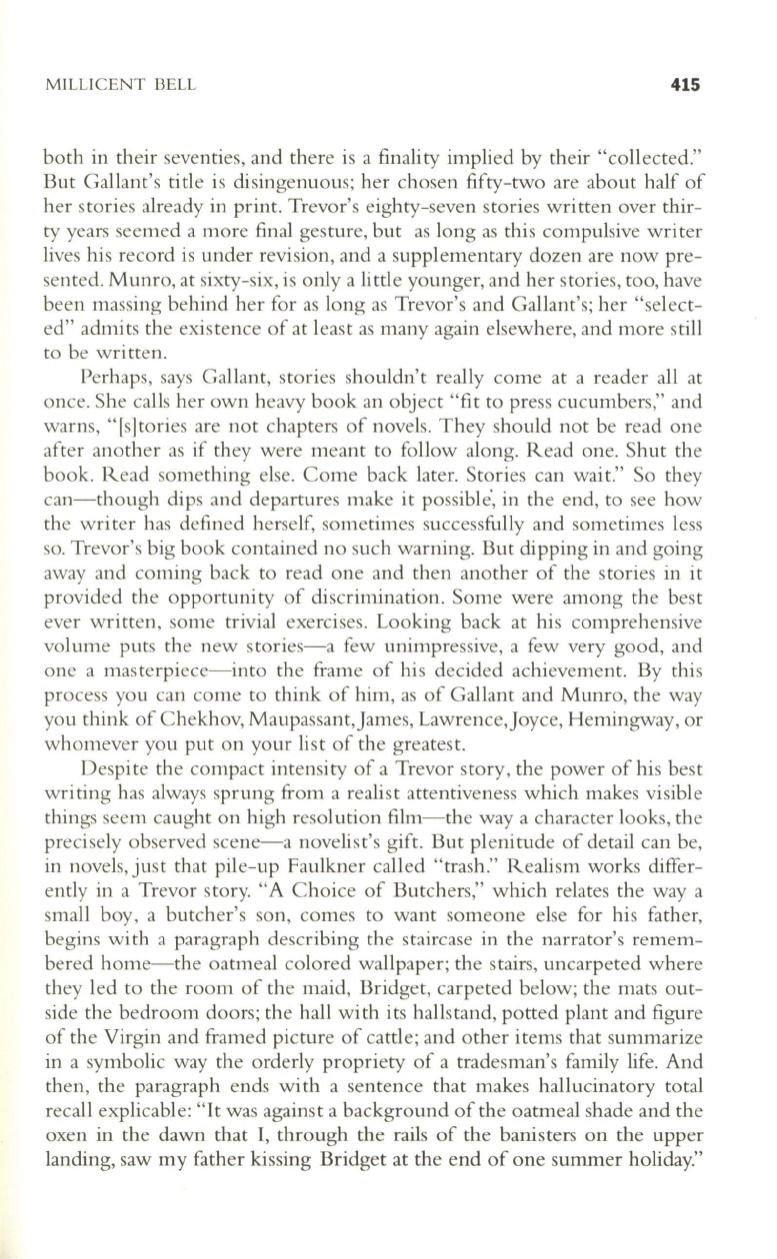
MILLICENT BELL
415
both in their seventies, and there is a finality implied by their "collected."
But Gallant's title is disingenuous; her chosen fifty-two are about half of
her stories already in print. Trevor's eighty-seven stories written over thir–
ty years seemed a more final gesture, but as long as this compulsive writer
lives his record is under revision, and a supplementary dozen are now pre–
sented. Munro, at sixty-six, is only a little younger, and her stories, too, have
been massing behind her for as long as Trevor's and Gallant's; her "select–
ed" admits the existence of at least as many again elsewhere, and more still
to
be wri tten.
Perhaps, says Gallant, stories shouldn't really come at a reader all at
once. She calls her own heavy book an object "fit to press cucumbers," and
warns, "[s]tories are not chapters of novels. They should not be read one
after another as if they were meant to follow along. Read one. Shut the
book. Read something else. Come back later. Stories can wait." So they
can-though dips and departures make it possible', in the end, to see how
the writer has defined herself, sometimes successfully and sometimes less
so. Trevor's big book contained no such warning. But dipping in and going
away and coming back to read one and then another of the stories in it
provided the opportunity of discrimination. Some were among the best
ever written, some trivial exercises. Looking back at his comprehensive
volume puts the new stories-a few unimpressive, a few very good, and
one a masterpiece-into the frame of his decided achievement. By this
process you can come to think of him, as of Gallant and Munro, the way
you think of Chekhov, Maupassant,James, Lawrence,Joyce, Hemingway, or
whomever you put on your list of the greatest.
Despite the compact intensity of a Trevor story, the power of his best
writing has always sprung from a realist attentiveness which makes visible
things seem caught on high resolution film-the way a character looks, the
precisely observed scene-a novelist's gift. But plenitude of detail can be,
in novels, just that pile-up Faulkner called "trash." Realism works differ–
ently in a Trevor story. "A Choice of Butchers," which relates the way a
small boy, a butcher's son, comes to want someone else for his father,
begins with a paragraph describing the staircase in the narrator's remem–
bered home-the oatmeal colored wallpaper; the stairs, uncarpeted where
they led to the room of the maid, Bridget, carpeted below; the mats out–
side the bedroom doors; the hall with its hallstand, potted plant and figure
of the Virgin and framed picture of cattle; and other items that summarize
in a symbolic way the orderly propriety of a tradesman's family life. And
then, the paragraph ends with a sentence that makes hallucinatory total
recall explicable: "It was against a background of the oatmeal shade and the
oxen in the dawn that
I,
through the rails of the banisters on the upper
landing, saw my father kissing Bridget at the end of one summer holiday."


